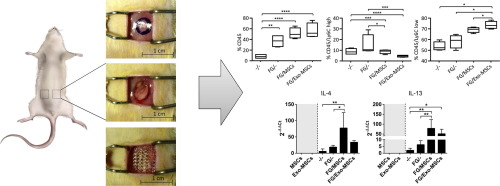Mesenchymal stem cells or exosomes with fibrin glue mesh fixation modulates the inflammatory reaction in a murine model of incisional hernia
Javier García Casado, Scientific Director of NANBIOSIS U14, Cell Therapy Unit, and Francisco Miguel Sánchez Margallo, Scientific Director of CCMIJU, are co-author of the publication “Fibrin glue mesh fixation combined with mesenchymal stem cells or exosomes modulates the inflammatory reaction in a murine model of incisional hernia” by Acta Biomaterialia.
In vitro experiments were performed by the ICTS Nanbiosis (Unit 14. Cell therapy at CCMIJU). Exosomes characterization was performed by the ICTS Nanbiosis (Unit 6: Biomaterial processing and Nanostructuring Unit). In vivo experiments were performed by the ICTS Nanbiosis (Unit 22. Animal housing at CCMIJU).
The study has demonstrated a significant increase of anti-inflammatory M2 macrophages and TH2 cytokines when MSCs or exo-MSCs were used. Moreover, the analysis of MMPs, TIMPs and collagen exerted significant differences in the extracellular matrix and in the remodeling process. The in vivo study suggests that the fixation of surgical meshes with FG and MSCs or exo-MSCs will have a beneficial effect for the treatment of incisional hernia in terms of improved outcomes of damaged tissue, and especially, in the modulation of inflammatory responses towards a less aggressive and pro-regenerative profil,
The implantation of surgical meshes is the standard procedure to reinforce tissue defects such as hernias. However, an exacerbated and persistent inflammatory response secondary to this implantation is frequently observed, leading to a strong discomfort and chronic pain in the patients. In many cases, an additional surgical intervention is needed to remove the mesh.
This study shows that mesenchymal stem cells and their exosomes, combined with a fibrin sealant, can be used for the successful fixation of these meshes. This new therapeutic approach, assayed in a murine model of incisional hernia, favors the modulation of the inflammatory response towards a less aggressive and pro-regenerative profile
For further information: DOI: https://doi.org/10.1016/j.actbio.2018.02.014.









